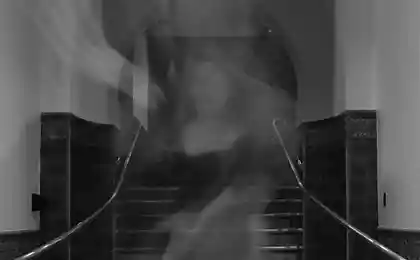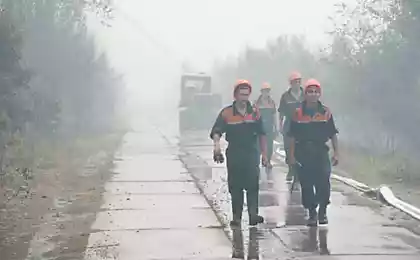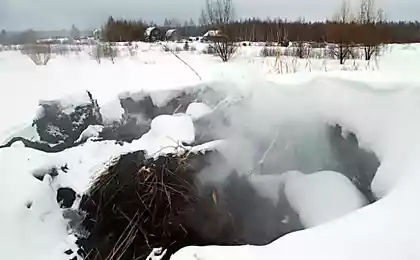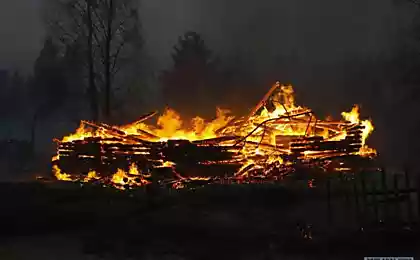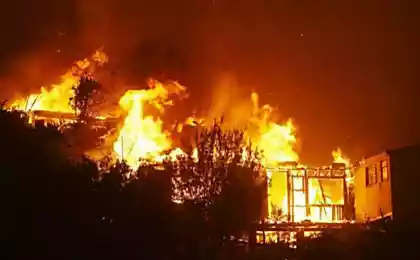956
The burning of Formula 1
In one of the collections of the burning car touched the topic of "the first Formula One." (In fact, there is a series of photos of the car IRL)
In this video, the fire occurred because no refueling equipment serviceability.
Here's a video of fire occurred on the road - Hockenheim, Germany, 1994.
Fuel broke out in consequence of the fact that the hood of the car is hot, because of the high operating temperature of the engine. Do not believe me? Then the next video for you, it is perfectly visible, as the engine red hot for a couple of minutes.
But these fires, so to speak "not afraid", much worse fires that occur in -those collision. In the following video - accident Niki Lauda, Nürburg-Ring (Shlyayfe Nord), Germany, 1976. It was after this accident, FIA has committed itself to improving safety in Formula 1.
Another fire. Kyalami, South Africa, 1973.
Although Formula 1 has become much safer, remember the risks faced by the pilots of F1, in order to entertain the audience.
P.S. we can say Formula 1 and fires are inseparable, still occur fire, thank God that they are not serious, just immediately eliminated.
And now, some of the fuel in Formula 1.
Good fuel in the tanks of the machine is one of the components of success in Formula 1. In the laboratories of the oil companies involved in the development, Army scientists are searching for the elixir of victory. Those who discover the formula for success, get a decisive advantage for their race cars when they are on the road. Nevertheless, there is something more important than speed: security riders and teams of mechanics at the pit stop.
Even during the birth of a Formula 1 fuel was one of the most important components for the win. Mixtures are then prepared - from substances such as benzene, methanol, acetone, nitrobenzene, - are, however, often so volatile that they had to be drained from the engine immediately after training and races. If you do not take this precaution, the engines would not survive the night. Mechanics who have dealt with this fuel, suffered chemical burns that required hospital treatment.

Fortunately, those days are behind us. Gradually, the International Automobile Federation (FIA) has reduced the list of permitted additives for safety reasons. However, the oil companies have continued to experiment with more than 300 mixtures in the early 90s. Only in 1993, the FIA put an end to these developments, requiring that the fuel used in Formula 1, satisfies all the rules of the European Union relating to safety and health. The speed of racing cars it had no effect. In fact, the improvement of fuel, approximately 250, 000 liters of which is used for research, tests and races each season, is still conducted on a highly professional level of the oil companies.
Requirements to be met by the fuel, which is intended to give the machine an extra portion of power for those crucial tenths of a second, very strict: it should be easy, and its consumption should be as low as possible, so that the weight of the machine can be kept to a minimum level and refueling stop for short stay.
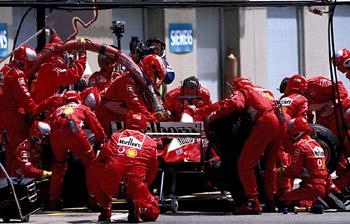
Refueling procedure itself does not leave any opportunity to save time. Standardized refueling system and pumped only 12 liters per second, corresponding to EU standards unleaded premium tank that is mounted behind the pilot's seat. As a precaution, and fire prevention during the crash of his body is made of deformable kevlar.

During refueling in Formula 1 and racer, and mechanics are well protected by fireproof overalls and helmet. Ordinary drivers themselves are at risk of danger at petrol stations. Although the probability of fire is relatively low due to safety regulations should always remember that petrol is volatile and flammable. Between 1993 and 2004 the number of fires at gas stations, which have been reported around the world, is still higher than the figure of 200.

Although optimal fuel is also important for the machine's capabilities on ordinary roads, in Formula 1, it is a tremendous competitive advantage. The ability to pass on the entire circle or two more than rivals with the same amount of fuel can have a decisive influence on the outcome of the race. Fuel consumption plays an important role in the strategy and is therefore among the most guarded secrets teams. According to experts, a Formula 1 car uses approximately 70 liters of fuel per 100 kilometers. In terms of performance, which reach racing cars, this makes them highly economical.

In order to ensure the use of only fuel allowed in Formula 1, each team must submit a sample to the FIA before the season started. During weekends Grand Prix FIA technicians take samples from randomly selected machines, storage tanks and filling machines, which are then analyzed and compared with representative samples in a special mobile laboratory on the racetrack. If the samples do not match, can be applied severe penalties. Can reach up to disqualification from the race. Usually, however, all the teams follow the rules - after all, you can get on the podium with just the right fuel.
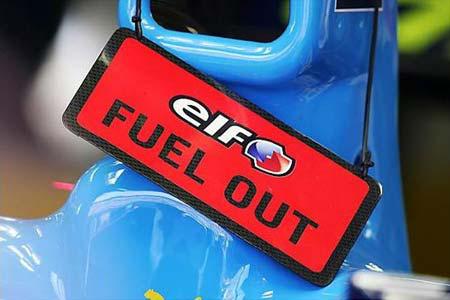
P.S. One who mastered at least half, we can put a monument
In this video, the fire occurred because no refueling equipment serviceability.
Here's a video of fire occurred on the road - Hockenheim, Germany, 1994.
Fuel broke out in consequence of the fact that the hood of the car is hot, because of the high operating temperature of the engine. Do not believe me? Then the next video for you, it is perfectly visible, as the engine red hot for a couple of minutes.
But these fires, so to speak "not afraid", much worse fires that occur in -those collision. In the following video - accident Niki Lauda, Nürburg-Ring (Shlyayfe Nord), Germany, 1976. It was after this accident, FIA has committed itself to improving safety in Formula 1.
Another fire. Kyalami, South Africa, 1973.
Although Formula 1 has become much safer, remember the risks faced by the pilots of F1, in order to entertain the audience.
P.S. we can say Formula 1 and fires are inseparable, still occur fire, thank God that they are not serious, just immediately eliminated.
And now, some of the fuel in Formula 1.
Good fuel in the tanks of the machine is one of the components of success in Formula 1. In the laboratories of the oil companies involved in the development, Army scientists are searching for the elixir of victory. Those who discover the formula for success, get a decisive advantage for their race cars when they are on the road. Nevertheless, there is something more important than speed: security riders and teams of mechanics at the pit stop.
Even during the birth of a Formula 1 fuel was one of the most important components for the win. Mixtures are then prepared - from substances such as benzene, methanol, acetone, nitrobenzene, - are, however, often so volatile that they had to be drained from the engine immediately after training and races. If you do not take this precaution, the engines would not survive the night. Mechanics who have dealt with this fuel, suffered chemical burns that required hospital treatment.

Fortunately, those days are behind us. Gradually, the International Automobile Federation (FIA) has reduced the list of permitted additives for safety reasons. However, the oil companies have continued to experiment with more than 300 mixtures in the early 90s. Only in 1993, the FIA put an end to these developments, requiring that the fuel used in Formula 1, satisfies all the rules of the European Union relating to safety and health. The speed of racing cars it had no effect. In fact, the improvement of fuel, approximately 250, 000 liters of which is used for research, tests and races each season, is still conducted on a highly professional level of the oil companies.
Requirements to be met by the fuel, which is intended to give the machine an extra portion of power for those crucial tenths of a second, very strict: it should be easy, and its consumption should be as low as possible, so that the weight of the machine can be kept to a minimum level and refueling stop for short stay.

Refueling procedure itself does not leave any opportunity to save time. Standardized refueling system and pumped only 12 liters per second, corresponding to EU standards unleaded premium tank that is mounted behind the pilot's seat. As a precaution, and fire prevention during the crash of his body is made of deformable kevlar.

During refueling in Formula 1 and racer, and mechanics are well protected by fireproof overalls and helmet. Ordinary drivers themselves are at risk of danger at petrol stations. Although the probability of fire is relatively low due to safety regulations should always remember that petrol is volatile and flammable. Between 1993 and 2004 the number of fires at gas stations, which have been reported around the world, is still higher than the figure of 200.

Although optimal fuel is also important for the machine's capabilities on ordinary roads, in Formula 1, it is a tremendous competitive advantage. The ability to pass on the entire circle or two more than rivals with the same amount of fuel can have a decisive influence on the outcome of the race. Fuel consumption plays an important role in the strategy and is therefore among the most guarded secrets teams. According to experts, a Formula 1 car uses approximately 70 liters of fuel per 100 kilometers. In terms of performance, which reach racing cars, this makes them highly economical.

In order to ensure the use of only fuel allowed in Formula 1, each team must submit a sample to the FIA before the season started. During weekends Grand Prix FIA technicians take samples from randomly selected machines, storage tanks and filling machines, which are then analyzed and compared with representative samples in a special mobile laboratory on the racetrack. If the samples do not match, can be applied severe penalties. Can reach up to disqualification from the race. Usually, however, all the teams follow the rules - after all, you can get on the podium with just the right fuel.

P.S. One who mastered at least half, we can put a monument



